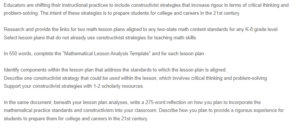Constructivism in Mathematics
Mathematical Lesson Analyses
| Lesson Plan 1 | ||
| Link to the lesson:
https://betterlesson.com/browse/common_core/standard/78/ccss-math-content-1-g-geometry?from=content_area_math |
Grade Level and State Content Standards:
Grade 1, Numbers and operations in base ten, Measurement and data |
|
| Components Within the Lesson Plan that are Aligned to Standards | · Assessment of fractional halves and fourths
· Finding rectangles · Identifying plane shapes · Making new shapes with shapes · Halves of cakes and clocks · Equal parts · Fare share: Fraction Story problems · Picnic basket fractions · Pizza party invasion · It’s not fair if she gets more cookies than me · Fraction Art · Halves · Fraction: Fourths |
|
| Constructivist Strategy that Involves Critical Thinking and Problem Solving | · Students working in groups (cooperative learning)
Group work allows the students to learn through interdependence. Solving certain problems in a group setting enables each student to understand important concepts of the subject. |
|
| Sources | (The State University of New York, 2021)
(Ramsook, 2018) |
|
| Lesson Plan 2 | ||
| Link to the Lesson:
https://betterlesson.com/browse/common_core/standard/119/ccss-math-content-2-g-geometry?from=content_area_math |
Grade Level and State Content Standards:
Grade 2 Measurement and data Geometry |
|
| Components Within the Lesson Plan that are Aligned to Standards | · Introduction to shapes
· Shape attributes · Angles · Geometric solids · Assessment of lines · Fractions can be fun · More than one name for a fraction · Numerators and denominators · Time and money fractions · Identification of shapes visually |
|
| Constructivist Strategy that Involves Critical Thinking and Problem Solving | · Pairs of students teaching each other (reciprocal teaching and learning)
Students can be paired up to share their knowledge on various elements of the lesson plan. This strategy allows the students to maximize their learning as they share knowledge with each other. The process invigorates learning in each of the students, making it fun. |
|
| Sources | (The State University of New York, 2021)
(Carter, 1997) |
|
Reflection
Constructivism is a theory that is increasingly being adopted in institutions for instruction. The learners can create or construct knowledge instead of passively consuming it from another source. The process of constructivist instruction engages students actively, making learning fun and more efficient. Learning is viewed as a social process, which implies that learners who work together are more likely to maximize the process than independent learners. In the social context, students are able to construct knowledge and internalize it subsequently. It is impossible to impart knowledge to learners (The State University of New York, 2021). Thus, proponents of the constructivism theory emphasize that teachers should create environments, opportunities, and experiences that encourage the construction of knowledge. To implement these aspects of the theory, tutors need to adopt various strategies for instruction purposes.
Cooperative learning is one of the strategies that promote the construction of knowledge. The strategy involves dividing the students into numerous groups. The creation of a social learning environment promotes the process of sharing knowledge among the participants. The students encounter mathematical problems and tap into each other’s knowledge to find a solution (The State University of New York, 2021). The interdependence allows all the group members to learn about the subject in detail, ask each other questions, provide different explanations than an instructor would, and explore their mathematical abilities. Reciprocal teaching and learning is similar to the first strategy. However, the students work in pairs and share their knowledge as they would in a group. Pairing students allows both individuals to tap into each other’s knowledge. The incorporation of these strategies in the class sessions is encouraged after the instructor has introduced basic concepts of fractions and the identification of shapes or geometry. Immediate discussion or sharing of knowledge allows students to internalize the new concepts (Carter, 1997). During the upcoming lessons or sessions meant for revision of class content, utilization of these strategies allows the learners to identify their problem areas and address them through their colleagues. Moving forward, the learners develop a culture of engaging in the process of constructing instead of just consuming knowledge.
References
Carter, C. J. (1997). Why Reciprocal Teaching? How Children Learn, 54(6), 64-68.
Ramsook, L. (2018). Cooperative Learning As a Constructivist Strategy in Tertiary Education. International Journal of Education and Research, 6(12), 149-160.
The State University of New York. (2021). Constructivism. Retrieved from Center for Educational Innovation: http://www.buffalo.edu/ubcei/enhance/learning/constructivism.html
ORDER A PLAGIARISM-FREE PAPER HERE
We’ll write everything from scratch
Question

Constructivism in Mathematics
Educators are shifting their instructional practices to include constructivist strategies that increase rigour in terms of critical thinking and problem-solving. The intent of these strategies is to prepare students for college and careers in the 21st century.
Research and provide the links for two math lesson plans aligned to any two-state math content standards for any K-8 grade level. Select lesson plans that do not already use constructivist strategies for teaching math skills.
In 550 words, complete the “Mathematical Lesson Analysis Template” and for each lesson plan:
Identify components within the lesson plan that address the standards to which the lesson plan is aligned.
Describe one constructivist strategy that could be used within the lesson, which involves critical thinking and problem-solving.
Support your constructivist strategies with 1-2 scholarly resources.
In the same document, beneath your lesson plan analyses, write a 275-word reflection on how you plan to incorporate the mathematical practice standards and constructivism into your classroom. Describe how you plan to provide a rigorous experience for students to prepare them for college and careers in the 21st century.

